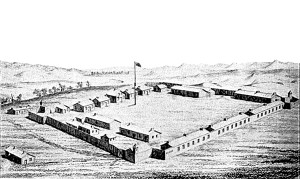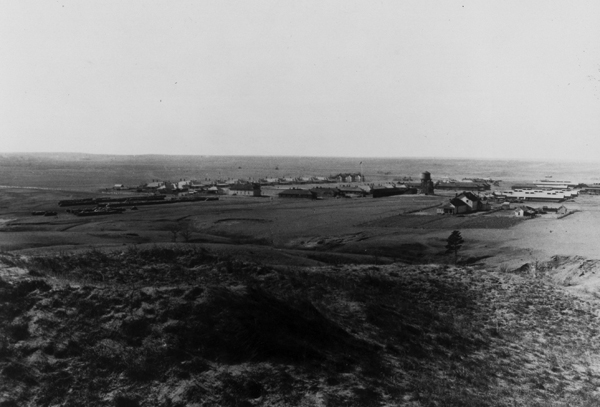Perhaps the most common question asked of staff at Fort Robinson, Nebraska, is “Where’s the fort?” Visitors who are only familiar with Hollywood depictions of forts are often surprised to discover that typical forts on the northern plains had no walls. But historian Thomas Buecker discovered that Hollywood wasn’t all wrong – some forts were enclosed. In the Spring 2014 issue of Nebraska History, Buecker categorizes enclosed northern plains forts into five types.
 Originally built as a palisade-enclosed fort, Fort C.F. Smith was rebuilt as a combination-enclosed type. Photo from the National Archives.
Originally built as a palisade-enclosed fort, Fort C.F. Smith was rebuilt as a combination-enclosed type. Photo from the National Archives.
For example, combination-enclosed forts were formed by the backs of separate buildings, with logs filling in the gaps. Wood was an expensive resource on the open plains, and using buildings as part of the wall was cheaper than completely enclosing them.
Some forts avoided the cost of lumber entirely by surrounding the post with dirt instead. These earthwork-enclosed forts were less common than combination-enclosed forts, and the earth walls and ditches had to be reinforced often because of erosion. However, earthwork-enclosed encampments allowed for simple additions if workers were available. In 1865, Fort Laramie dug three battery emplacements and a trench to improve defenses along the northeastern side. Fort Kearny also dug extra fortifications during the 1864-1865 Indian War. Neither fort was ever directly attacked, and the fortifications were not used.
 Plan of Fort Wadsworth (renamed Sisseton in 1876) with enclosing six-foot-high earthwork (highlighted). Philip H. Sheridan, Outline Descriptions of Posts in the Military Division of the Missouri.
Plan of Fort Wadsworth (renamed Sisseton in 1876) with enclosing six-foot-high earthwork (highlighted). Philip H. Sheridan, Outline Descriptions of Posts in the Military Division of the Missouri.
In the late 1860s and 1870s, some officers began to question the efficiency of enclosing forts at all. Gen. Philippe de Trobriand, commander of the District of Dakota, felt that enclosed forts seemed like prisons. Other commanders felt that enclosed forts made soldiers lazy and content to hide rather than fight. The military’s opinion on post fortification shifted drastically during those years. More Indians were confined to reservations and the need for forts diminished. After the Great Sioux War in the late 1870s, all new forts were completely open and the era of enclosed plains forts was over.
 Fort Niobrara. seen from east about 1895, was one of the new generation of fully open army posts built on the northern plains. Photo from the National Archives.
Fort Niobrara. seen from east about 1895, was one of the new generation of fully open army posts built on the northern plains. Photo from the National Archives.
Buecker’s article is a part of a special issue of Nebraska History, “After the Indian Wars: People, Places, and Episodes,” which presents six papers from the Ninth Fort Robinson History Conference.
To read more about enclosed army posts, you can order a copy of the magazine by calling the Landmark Store at 402-471-3447.
– Joy Carey, Editorial Assistant, Publications



